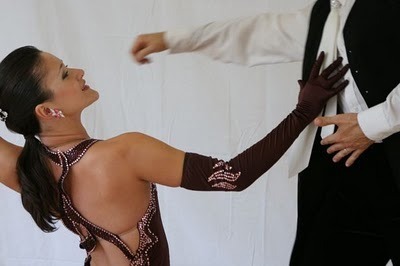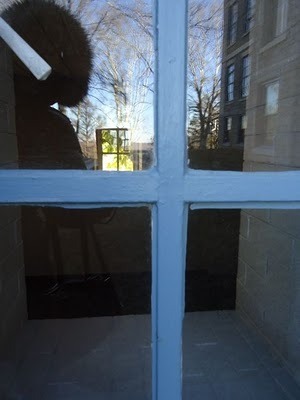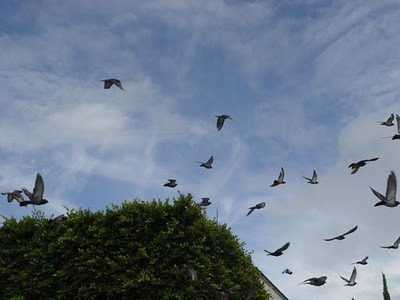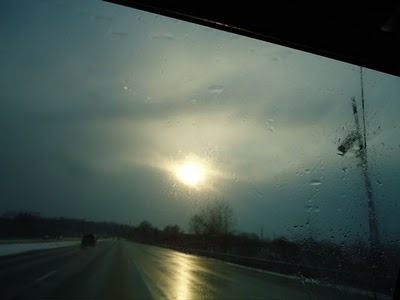Beth Kephart's Blog, page 264
January 10, 2011
Sometimes it snows and suns at the exact same moment
Published on January 10, 2011 05:09
January 9, 2011
You will be reading about her.
 You will be following her song to the ends of this earth. You will scour every store for the single unclaimed Dora doll or Monkeyboots balloon or bag of chocolate-encrusted pretzels. You will watch her little fingers work, and they will evoke for you a long ago, an urgent present tense.
You will be following her song to the ends of this earth. You will scour every store for the single unclaimed Dora doll or Monkeyboots balloon or bag of chocolate-encrusted pretzels. You will watch her little fingers work, and they will evoke for you a long ago, an urgent present tense. And you will feel her arms around you long after you have driven away; you will hear her in your dreams that night: Cheese. Cheese. Cheese. Thank you.




Published on January 09, 2011 02:49
January 8, 2011
Brain training through ballroom dance
 I've been a big Sharon Begley fan for years now, and so when I saw that she had written a feature Newsweek story titled "Can You Build a Better Brain?" (January 10 and 17, 2011) I flipped the pages and settled in.
I've been a big Sharon Begley fan for years now, and so when I saw that she had written a feature Newsweek story titled "Can You Build a Better Brain?" (January 10 and 17, 2011) I flipped the pages and settled in.After reviewing all the things that don't have any proven tie to enhanced brain intelligence (those vitamins, the Mediterranean diet, statins, ibuprofen), Begley begins to center in on things that are known to help—exercise, meditation, and complex videogames. You have to read the whole article to get the complete and utter gist, but I'm going to quote from the paragraph that made me happiest of all:
... taking up a new, cognitively demanding activity—ballroom dancing, a foreign language—is more likely to boost processing speed, strengthen synapses, and expand or create functioning networks.Ballroom dancing—did you see that folks? It ain't just about the glitter and the gloves.
Speaking, however, of glitter and gloves, that gorgeous woman in the photograph here is our own Cristina, of DanceSport Academy, whose little Eva is turning two this month. If learning the rumba doesn't keep us young, this wondrous sprite of a child is bound to do the trick.




Published on January 08, 2011 09:19
Author of Florinda's Year
 I took this photograph from the fourteenth floor of an Atlantic City hotel two nights ago and said to myself, You won't be using this one until something really special happens.
I took this photograph from the fourteenth floor of an Atlantic City hotel two nights ago and said to myself, You won't be using this one until something really special happens.This morning I woke to a note about something that is, to me, so very touching and special: Florinda of The 3 R's Blog has named me her author of the year and cited The Heart is Not a Size as one of her two top young adult reads of 2010.
Hearts are not, in the end, a size. But mine is very full. Thank you.




Published on January 08, 2011 03:45
January 7, 2011
Jane/April Lindner: Reflections
 This time, I begin at the back, with the featured book's final pages. I begin, in other words, with the author's note and acknowledgments folded into April Lindner's debut novel, Jane, her modern-day retelling of Charlotte Bronte's Jane Eyre.
This time, I begin at the back, with the featured book's final pages. I begin, in other words, with the author's note and acknowledgments folded into April Lindner's debut novel, Jane, her modern-day retelling of Charlotte Bronte's Jane Eyre. It's in the author's note that Lindner writes of being on Team Charlotte (Bronte, as opposed to Team Jane Austen)—of her love for Jane, the "freethinker," and for Mr. Rochester, "the sexiest guy in literature." It's in the acknowledgments that Lindner explains that her 21st century Mr. Rochester, a rock star named Nico Rathburn, was inspired by none other than Bruce Springsteen, the "rocker who has given me so much inspiration, solace, and joy, and who has served as a model of how an artist giving his all can truly work magic in the night. Without the soul-transporting music and electrifying stage presence of Bruce Springsteen and the legendary E Street Band, this book would not have been written. It's that simple."
I don't know why I tend to read the back of books first, but I do, and in this case, it was just what I needed to put Lindner's novel into context. Lindner's passion for Jane Eyre is transparent in these pages. She is utterly true to the arc of the original—presenting us with a sensible young woman who finds herself taking a nanny job in the estate of a brooding, wealthy rocker. Strange things occur in this Rathburn estate (called Thornfield), and Jane's not the kind of girl any one would peg as the would-be girlfriend of a troubled-past rocker. But things unfold as they must, and soon Jane and Nico are deeply in love with each other—engaged to be married and just about to tie the knot when the terrible secret at the heart of Thornfield is revealed.
Those who have read the original Jane Eyre will know what happens next, but it's fun to see just how Lindner pulls this all off—where she takes 19-year-old Jane, how she evolves the rocker, and how she gives this romance its final hopeful breaths. I read the book in a single sitting, intrigued by the premise and wishing that Lindner and I had together gone to a Springsteen concert, or two. I suspect she'd be a delightful, joyous companion.




Published on January 07, 2011 13:59
Atlantic City, Five P.M.
Published on January 07, 2011 11:58
January 6, 2011
The exquisite Teen Reads Too review of Dangerous Neighbors
 If you are wondering why I am posting images of flowers today, in the midst of winter, it's because flowers have been sent to me by way of two utterly unexpected reviews—the first by the utterly original and gracious Bookalicio.us and now this, by the eloquent Melanie Foust of Teen Reads Too, who has granted Dangerous Neighbors a gold star. She writes, among other things:
If you are wondering why I am posting images of flowers today, in the midst of winter, it's because flowers have been sent to me by way of two utterly unexpected reviews—the first by the utterly original and gracious Bookalicio.us and now this, by the eloquent Melanie Foust of Teen Reads Too, who has granted Dangerous Neighbors a gold star. She writes, among other things:National book award finalist Beth Kephart has written another gorgeous novel full of characters that are slowly brought to life. By the time the end of the novel came around, I found myself fully invested in the life of Katherine and those closest to her. This book held my attention from beginning to end, first because of its suspenseful opening and then its enlightening flashbacks, showing what has brought Katherine to such a dark time in her life.
Thank you, Teen Reads Too and Melanie Foust.




Published on January 06, 2011 07:10
Reading as a contact sport: The Bookalicio.us review of Dangerous Neighbors
 Ever since I published my first book I dreamed of finding a stranger somewhere—anywhere—curled up with one of my stories. It has happened only once; I was walking the path by the Schuylkill River and found a woman paging through Flow. And once, of course, dear James Lecesne could be spotted reading Dangerous Neighbors on an Amtrak train, but that doesn't really count, in the oh-my-gosh-what-a-surprise way of things, for I'd handed him the book hours before at the BEA.
Ever since I published my first book I dreamed of finding a stranger somewhere—anywhere—curled up with one of my stories. It has happened only once; I was walking the path by the Schuylkill River and found a woman paging through Flow. And once, of course, dear James Lecesne could be spotted reading Dangerous Neighbors on an Amtrak train, but that doesn't really count, in the oh-my-gosh-what-a-surprise way of things, for I'd handed him the book hours before at the BEA.Because, as you all know, I never google my own name or check Amazon ratings, I don't operate with any sense of who might be reading which of my books right now (nor do I ever presume that people are). And so, when, quite accidentally, I came upon this Bookalicio.us review of Dangerous Neighbors today, I felt that happy thing that happens inside when I know that a reader has been out there in the midst (and mist), and that a reader has read with such generosity and grace.
I will, however, confess to feeling badly for our reviewer, Pam, from whom I learned, in this paragraph, that reading can be a contact sport:
Beth Kephart is such a fantastic writer that I am always in awe of her prose and story telling ability, so much so that reviewing any piece of literature from Kepharts small but growing canon is always hard for me to accomplish. Kephart is astonishingly capable of making her characters come to life in such a way that putting down the book to do menial tasks such as walking the hound become impossible. Which is why August of 2010 will always be known to me as the month that I learned walking the dog while reading results in severe coordination disability, causing walking into a pole, nose bleeds, and incredible embarrassment to all who try. This life lesson is just one of the things Kephart has taught me while reading her books.Thank you so much, Pam.




Published on January 06, 2011 02:42
January 5, 2011
Kit Armstrong, the original prodigy
 I have taught in many places, and been educated by many children. Chanticleer garden has been the backdrop of some of my most treasured teaching memories. If we lose some of the children we meet along the way, we never forget them.
I have taught in many places, and been educated by many children. Chanticleer garden has been the backdrop of some of my most treasured teaching memories. If we lose some of the children we meet along the way, we never forget them.Tonight, at dinner, apropos of nothing, my son asked whatever happened to Kit Armstrong, one of the students I had the privilege of getting to know six summers ago. He'd come to us (via Betty Jean) as a young composer—a 12-year-old (at the time) who already had seven years of composition and piano studies under his belt, who had enrolled as a full-time undergraduate student in music and science by the age of nine, and who was known for his bowtie stints on the David Letterman Show. He'd not had the chance to explore creative writing when I first met him, but he emerged at once as a talent. More than that, always more importantly than that, he was this kid that we all quickly grew to love. No snobbery in him. No better-than-ism. Just this kid who loved music and science and language, and whose laugh made us laugh, whenever we heard it in the garden.
"I don't know what happened to Kit," I told my son, who sensed my sadness at once. "Google him," my son said. And, of course, I just did.
How happy does it make me to find Kit here, on his web site, as beautiful as he was six years ago. How delighted am I to learn that just this summer he was awarded the "Leonard Bernstein Award" and that his piano repertoire (and I quote) "includes the 48 Preludes and Fugues from the Well-Tempered Clavier by Bach, all Mozart Piano Sonatas, 15 Beethoven Piano Sonatas, as well as works by Haydn, Schubert, Chopin, Schumann, Liszt, Debussy, Ravel, Bartok, and Ligeti. His concerto repertoire comprises works by Bach, Mozart, Beethoven, Chopin, Schumann, and Bartok." If that doesn't impress you, then how about this: He was awarded the Morton Gould Young Composer Award for five consecutive years, and he now performs all over the world with major orchestras.
People like Kit don't come around too often. I am waving to him now, across the internet.




Published on January 05, 2011 17:01
Kamchatka/Marcelo Figueras: Reflections
 Because I can't find the right photograph, because maybe this is the right photograph—these birds leaving but also going toward. Because "time," Marcelo Figueras writes in his masterful Kamchatka, "is weird." Because time bends, and when we are reading novels like this one—so rich with knowing, and yet so vulnerable—time doesn't exist at all.
Because I can't find the right photograph, because maybe this is the right photograph—these birds leaving but also going toward. Because "time," Marcelo Figueras writes in his masterful Kamchatka, "is weird." Because time bends, and when we are reading novels like this one—so rich with knowing, and yet so vulnerable—time doesn't exist at all.The year is 1976, the place is Buenos Aires, and there is a family on the run from the military now in power. A ten-year-old boy is telling this story, but not really—it is the ten-year-old remembered by a later self looking back, by a man who writes, early in these pages:
Every day, life gives us an intimation of this. We sense that, inside us, every 'we' we once were (and will be?) coexists: the innocent self-absorbed child, the sensual young man generous to a fault, the adult, feet planted firmly on the ground yet still clinging to his illusions, and finally we are the old man who knows that gold is just another metal; as his eyesight fails he has acquired visionSo that we meet the family as the boy recalls his family—the sensationally imperfect and wholly loving mother who abruptly pulls her children from school; the father who joins them at a safe house outside the city; the brother Midget; the comrade Lucas; the surviving grandparents. It's just a family and they're just living—trying to keep the toads from committing suicide in the pool, playing killer games of Risk at night, mixing up their chocolate milk, watching nostalgic movies, and staying, always, one step ahead of those who hope to disappear them. You know how this story ends within the very first line of the book: "The last thing papa said to me, the last word from his lips, was 'Kamchatka.'" But Figueras writes with such excellent authority that we are soon hoping against hope (as a ten year old boy hopes against hope) that fate will spare this family, that Houdini magic will keep them safe.
How can I share, in this small space, the brilliant texture of this book—the biology, history, and language lessons that Figueras weaves in through devastatingly beautiful domestic scenes, the big riffs on life, the insistence on love? I felt as if I were watching some of my favorite movies of all time, "My Father's Glory" and "My Mother's Castle." I wanted to stop time, but I can't stop time, and even so, it took me several days to read to the end.
Kamchatka was first published in 2003; its author is both a screenwriter and a novelist, and indeed this book appeared on the silver screen some nine years ago. Black Cat is bringing the book out sometime this spring for American audiences.
You're going to thank them for that.




Published on January 05, 2011 09:42









